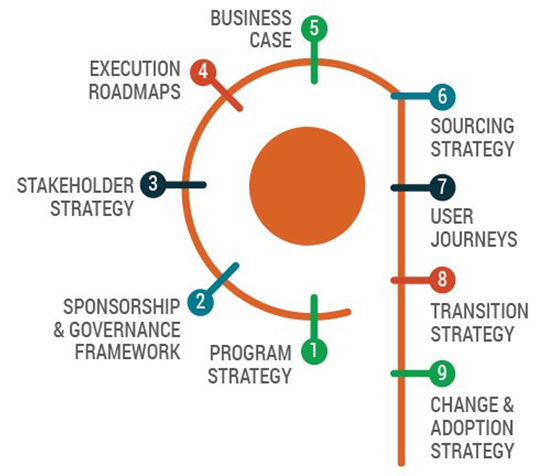A 9-Step Roadmap for Successful Business Transformation
Receive free IIBA updates and exclusive content!
Strategic business analysis helps organizations enable successful business transformation. The Strategy to Execution Framework® that is set to re-launch next month will provide the foundations and transparent pathways for business change to bridge the gap between strategy and execution.
Learn More: Get your preview copy of the Strategy to Execution Framework now!

Research from McKinsey and Company shows that 70% of all transformations fail1
Depending on the size of the program the cost of failures can run into hundreds of billions. Working with sponsors of large programs there are a number of scenarios that happen, most commonly business leaders report not gaining enough traction or programs are put on hold and the sponsor doesn’t know how to move it forward so the program comes to a standstill. Working with many organizations in Australia using the nine steps outlined in the framework, Dr. Cecily Macdougall consistently saw more successful implementations, lower business risks and costs, and an 80% adoption in the first three months after implementation.
The Strategy to Execution Framework Enables Desired Business Outcomes
The Strategy to Execution Framework closes the gap between strategy and execution and provides Business Analysis Professionals with a bridge to the implementation of a transformation program. The Framework includes nine elements and strategies to strategic change. By implementing these steps, those who practice strategic analysis can increase program or project success and achieve desired business outcomes.
Watch Now: What can the Strategy to Execution Framework do for your Organization
The 9 Elements of the Strategy to Execution Framework

The nine steps to strategic change in the Strategy to Execution Framework enable successful implementation of change and transformation. The steps include:
- Program Strategy -- The program strategy provides the foundations for a transformation or change. It helps to determine how to solve business problems in a way that will ensure the best result.
- Sponsorship and Governance Framework -- The sponsorship and governance framework creates a terms of reference document that outlines the program organisation structure, roles, and responsibilities of each of the functional areas.
- Stakeholder Strategy -- The purpose of the stakeholder strategy is to form partnerships with the stakeholders, with the “term partnership” referred to as establishing working and committed relationships.
- Execution Roadmaps -- Execution roadmaps have value because they provide a high-level view of all the moving parts of programs in context. They also provide focus on the outcome and what is needed when and by whom.
- Business Case -- A business case captures the reasoning and justification for initiating the program or project and the anticipated commercial benefits. It enables the executive to make an investment decision.
- Sourcing Strategy -- A sourcing strategy guides procurement. It ensures alignment with the information, communication, and technology (ITC) strategy.
- User Journeys -- User journeys are the visualization of the strategy. Their construction leverages design thinking and are part of sensemaking for stakeholders.
- Transition Strategy -- A transition strategy focuses on the long-term strategy of the transformation and the future releases and generations. It helps inform the sourcing strategy and procurement of services for ongoing support and maintenance of products and services.
- Change and Adoption Strategy -- A change and adoption strategy focuses on adoption and the strategies for change. It is key to delineating the strategic change and activities required for the transformation and the organisation change and activities required.
The source of the information above can be found in IIBA’s Strategy to Execution Framework preview edition.
Real-Life Results of Implementing the 9 Elements to Strategic Change
A Strategic Business Analyst used the nine steps to cause a particular program they were assigned to to gain more momentum. The assignment was to replace current technology with new technology. However, the expectation was that the process, data, people, and information would remain the same.
The outputs of the Framework enabled the sponsor to gain the confidence of and obtain buy-in from the CEO, executives, peers, and stakeholders. Obtaining this level of buy-in translated to the sponsor obtaining sufficient funding and other resources. The sponsor became empowered to move to procurement and implementation. Ultimately, the outputs of the Strategy to Execution Framework enables the success of the project/program.
Download your FREE preview edition of the Strategy to Execution Framework now.
IIBA’s Global Corporate Program provides the support and resources organizations need to build business analysis capabilities and drive professional development and growth.
To learn more, fill out the form below to speak with a Corporate Program Manager.
About the Author

Dr. Cecily Macdougall (1958–2022) was a practitioner and researcher in strategic change for more than 20 years. She specialized in transformation and driving strategy to execution. Cecily used the Strategy to Execution Framework to initiate and re-establish many complex, high-risk, transformation programs. She was experienced in health, education, IT, and business, with roles both on the client side and service provider side. She had extensive experience in government at the local, state and national levels. A thought leader, she published many articles about the different aspects of change programs and portfolios and published a novel incorporating a model to build mental health and resiliency. Cecily was also an entrepreneur and created and commercialized several products and services, founding a small services company for services and thought leadership.
